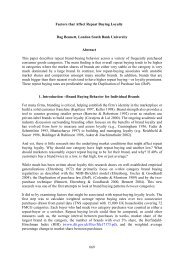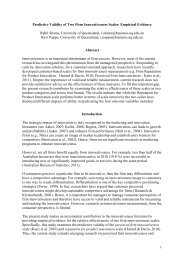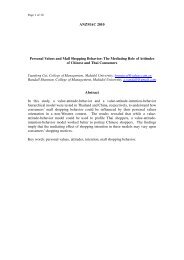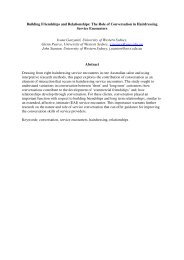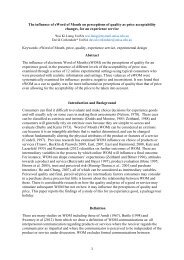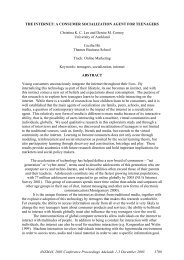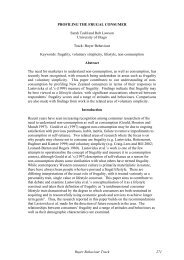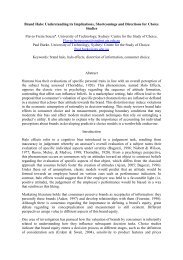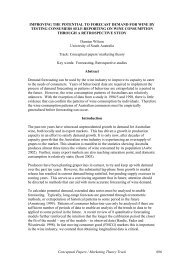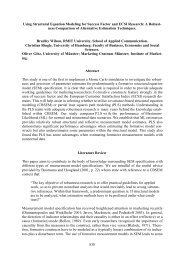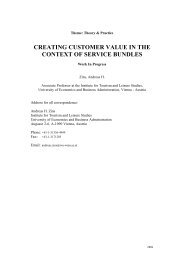A CONCEPTUAL MODEL OF TOURISM DESTINATION ...
A CONCEPTUAL MODEL OF TOURISM DESTINATION ...
A CONCEPTUAL MODEL OF TOURISM DESTINATION ...
Create successful ePaper yourself
Turn your PDF publications into a flip-book with our unique Google optimized e-Paper software.
that aimed mainly at stimulating tourist volumes. In most cases results have not been<br />
as expected, leading to questioning of this strategy. Empirical evidence has shown<br />
that to secure long-term profits and continued patronage, it is essential to have<br />
competitive advantages (Poon 1993).<br />
A destination, according to the New Shorter Oxford Dictionary is defined as ‘the<br />
place to which a person or thing is going, the intended end of a journey.’ However<br />
when applied to the tourism context, authors have offered different perspectives of<br />
what constitutes a tourism destination. For example, Buhalis, (2000) defines<br />
destinations as places that offer an amalgam of tourism products and services, which<br />
are consumed under a brand name of the destination. He argues that ‘they are well<br />
defined geographical regions, understood by visitors as unique entities with a core of<br />
six main provisions, i.e. attractions, accessibility, available packages activities and<br />
ancillary services. Other definitions have also been proposed by Leiper (1990; 1995)<br />
and Hu and Ritchie (1993). The World Tourism Organisation recently defined a<br />
destination as “..a physical space in which visitors spend at least one night and is<br />
made up of tourism products such as support services and attractions, and tourism<br />
resources with physical and administrative boundaries that define its management,<br />
images/ perceptions of market competitiveness” (World Tourism Organisation<br />
2003b).<br />
Destination Attractiveness<br />
The attractiveness of a destination reflects the feelings and opinions of its visitors<br />
about the destination’s perceived ability to satisfy their needs. The more a destination<br />
is able to meet the needs of the tourists, the more it is perceived to be attractive and<br />
the more the destination is likely to be chosen. Mayo and Jarvis (1980), define<br />
attractiveness as, ‘the perceived ability of the destination to deliver individual<br />
benefits’. This ability is enhanced by the attributes of a destination, i.e. those<br />
components that makeup a destination. This is a demand side perspective of the<br />
destination. The importance of these attributes help people to evaluate the<br />
attractiveness of a destination and make relevant choices.<br />
The attractiveness of a tourist destination encourages people to visit and spend time at<br />
the destination. Therefore the major value of destination attractiveness is the pulling<br />
effect it has on tourists. Without the attractiveness, tourism does not exist and there<br />
could be little or no need for tourist facilities and services. It is only when people are<br />
attracted to a destination that facilities and services follow (Ferrario 1979b).<br />
Destination competitiveness<br />
“Competitive strategy is the search for a favourable competitive position in an<br />
industry. It aims to establish a profitable and sustainable position against the forces<br />
that determine industry competition” (Porter 1985). The search for the forces and<br />
factors that determine the competitiveness of the tourism industry is an area that has<br />
not been fully explored (Dwyer et al. 2003a). In tourism context, the concept of<br />
competitiveness has been applied to different settings. Various authors have linked<br />
competitiveness to economics, marketing and strategic perspectives, price, quality and<br />
satisfaction.<br />
A destination can be said to be competitive if its market share, measured by visitor<br />
numbers and financial returns are increasing (Hassan 2000). This approach supports<br />
the widely held view that competitiveness should be linked to high visitor numbers<br />
and increasing destination income. Recent studies have shown that growth in tourism<br />
Conceptual Papers / Marketing Theory Track 638



